THE American WESTERN
By Jeffrey-Baptiste Tarlofsky
By Jeffrey-Baptiste Tarlofsky
Lesson 25 consists of 6 video lectures and transcripts of those lectures, and 4 film excerpts. Start with the lecture, Part 1 and continue down the page in sequence until you reach the end of the lesson.
レッスン25は、6本のビデオレクチャー(レクチャーのテキストがビデオレクチャーの下に記載されています)と4本の動画で構成されています。
このレッスンは、最初のLecture Part 1から順番に動画を見たりテキストを読んでください。
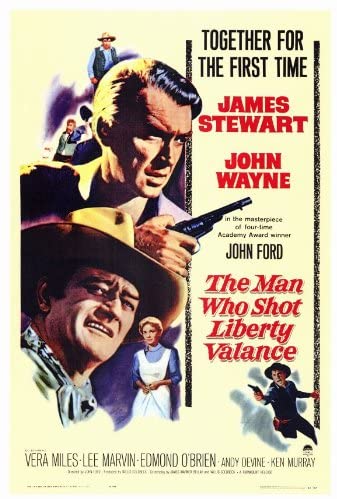
Directed by John Ford
Produced by Willis Goldbeck
Screenplay by James Warner Bellah and Willis Goldbeck
Based on a 1953 short story by Dorothy M. Johnson
Starring John Wayne, James Steward, Lee Marvin, Vera Miles
Music by Cyril J. Mockridge
Cinematograph: William H. Clothier
Running time: 123 minutes
Budget: $3.2 million
Box office: $8 million
Part 1 – In our last class, I said Ransom Stoddard had a secret weapon. That weapon was education. When Ransom learned that Hallie could not read or write he quickly understood that her problem was not unique. Recall that the early settlers to the West were mostly men and these men were hunters, trappers, and traders at first, and then ranchers, cowboys, and farmers next. None of these professions required literacy and, in any case, it would have been highly unlikely that an adult man in one of the professions would have taken the time from his work to learn to read. What we saw happening in The Left-handed Gun, when Mr. Tunstall (a well-educated English immigrant) started to teach Billy how to read, was really quite unusual. By the way, that part of the movie was not made up. Tunstall really did start to teach William (Billy) Bonny how to read and Billy was an eager and curious student before his teacher was murdered.
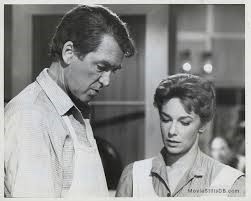 However, it was generally the women in the West who were either literate themselves or who insisted that their children learn to read and write. In Hallie’s case, she suffered an additional disadvantage because both her parents were non-native speakers of English (they came from Sweden). They might have been literate in Swedish, but it would have been challenging for them to teach their daughter to read English when they themselves were learning English as a second language. Later we learn that Hallie’s mother, Nora, is also unable to read English.
However, it was generally the women in the West who were either literate themselves or who insisted that their children learn to read and write. In Hallie’s case, she suffered an additional disadvantage because both her parents were non-native speakers of English (they came from Sweden). They might have been literate in Swedish, but it would have been challenging for them to teach their daughter to read English when they themselves were learning English as a second language. Later we learn that Hallie’s mother, Nora, is also unable to read English.
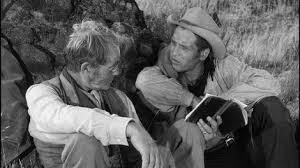 Hallie is a typical child of immigrants. She has grown up as a fluent native English speaker, far more fluent in English than either of her parents. Children learn their first language without difficulty whether they go to school or not. The human brain is “hard-wired” to learn a first language just as we are all naturally able to walk unless we have a disability of some kind. But reading is quite another matter. Learning to read requires special training, i.e., education. Some parents (almost always the mother) in the West would have taught their children to read, but clearly Nora and Peter were not able to teach Hallie because they themselves were not able to read in English. Perhaps because the United States is a nation of immigrants like Peter and Nora, this explains why free public education became one of the nation’s highest priorities, at least in the North and the East. Immigrant parents were less fluent in the new language than their children and so less able to teach them to read English at home. But the West was slower to adopt universal free education at first partly because so many Westerners were single men and also because so many of these men were originally from the South.
Hallie is a typical child of immigrants. She has grown up as a fluent native English speaker, far more fluent in English than either of her parents. Children learn their first language without difficulty whether they go to school or not. The human brain is “hard-wired” to learn a first language just as we are all naturally able to walk unless we have a disability of some kind. But reading is quite another matter. Learning to read requires special training, i.e., education. Some parents (almost always the mother) in the West would have taught their children to read, but clearly Nora and Peter were not able to teach Hallie because they themselves were not able to read in English. Perhaps because the United States is a nation of immigrants like Peter and Nora, this explains why free public education became one of the nation’s highest priorities, at least in the North and the East. Immigrant parents were less fluent in the new language than their children and so less able to teach them to read English at home. But the West was slower to adopt universal free education at first partly because so many Westerners were single men and also because so many of these men were originally from the South.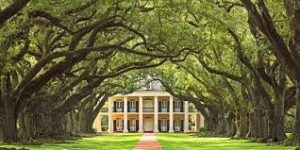
The South, both before and after the Civil War, was far less literate than the North. For one thing, it was illegal for any Black slave to be taught how to read. That meant that fully one-third of the people were kept illiterate by law. Moreover, the rate of literacy among the White population was also much lower than it was in the North. In the North where the economy was more mixed and the middle class was stronger, and immigrants a higher percent of the population, free public education was a much higher priority. But in the South, which was almost entirely an agricultural economy, there was a huge gap between the owners of large cotton plantations with many slaves and regular farmers. The wealthy plantation owners were unwilling to pay taxes to fund public education for the poor farmers. The rich hired private tutors for their own young children (and then sent them North for further education when they were older). Average farmers did not have many public schools for their children and what they did have was much less than children in the North had.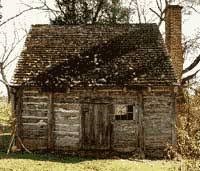
During the Civil War, the armies of the North not only invaded the South, they destroyed much of it as well. Cities and towns were burned to the ground and so were many large plantations and small farms. The wealthy white Southerners were greatly reduced in wealth and power, but they still controlled what wealth there was in the South. On the other hand, the poor white farmers who made up the bulk of the Confederate army often returned home to find their homes and farms burned down. In any case, the economy of the South was also destroyed. They often had nothing left. This is why so many of these men went West, often with no more than the clothes on their backs, a horse, and a gun. They were the men who took the jobs as cowboys, miners, railroad workers that required no literacy. It is really only with the arrival of newer immigrants from abroad (like Hallie’s family) and farming families from both the North and the South (with mothers and children like the Starrett family in Shane) that free public education in the West became a priority.
Ransome Stoddard’s recognized that the need for free education in his community was linked to their need for law and order. He realized that before the people can understand and accept the law, they need basic literacy. Let’s see how he approaches this challenge in this excerpt
Part 2 – Ransom is a natural teacher; eager and energetic, humble, and modest. He is the kind of teacher many of us remember for the rest of our lives because he made learning meaningful to our lives. Even while he is teaching the young children in the class their “ABCs”, he knows that you cannot just teach adults (or young adults) as if they were little children…even if they cannot read. Adults and young adults need a purpose for learning and Ransom gives his students this purpose by teaching them something they care about, their country, and how it works!
The immigrant, Nora, is proud to explain, even in her broken English, that a republic is a country in which the people are the boss. That’s us!” She explains that because people have the right to vote for the people who make the laws if those lawmakers “don’t do like we say, then we don’t for them no more!” “Anymore!”, corrects another student, Julieta, who is also the daughter of an immigrant mother like Nora, but who, again, speaks fluent English like Hallie.
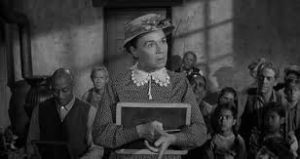 Ransom moves on to the next question, which is about the “basic law of the land” and once again clever Julieta wants to answer the question, but Pompey shyly raises his hand and like a good teacher should, Ransom gives the shy student the chance to answer. But Pompey is much more than just a shy student, he is also, most likely, a freed slave. The character Pompey was played by Woody Strode who was, at age forty-eight, was playing a much younger character just as both John Wayne and Jimmy Stewart were. If he was about the same age as Tom and Ransom are supposed to be, about twenty-five, this would mean he was most likely born into slavery and denied any schooling in his youth. It wasn’t only white Southerners who went West seeking their fortunes, many freed slaves from the South also went West. It is estimated that fully 25% of cowboys in the old West were former Black slaves. So…you ask…why haven’t we seen any Black cowboys in any of the movies we have watched so far, not even one? The answer is discrimination. Hollywood was a deeply racist institution and it simply chose to mostly ignore or change the history of Black Americans in the West.
Ransom moves on to the next question, which is about the “basic law of the land” and once again clever Julieta wants to answer the question, but Pompey shyly raises his hand and like a good teacher should, Ransom gives the shy student the chance to answer. But Pompey is much more than just a shy student, he is also, most likely, a freed slave. The character Pompey was played by Woody Strode who was, at age forty-eight, was playing a much younger character just as both John Wayne and Jimmy Stewart were. If he was about the same age as Tom and Ransom are supposed to be, about twenty-five, this would mean he was most likely born into slavery and denied any schooling in his youth. It wasn’t only white Southerners who went West seeking their fortunes, many freed slaves from the South also went West. It is estimated that fully 25% of cowboys in the old West were former Black slaves. So…you ask…why haven’t we seen any Black cowboys in any of the movies we have watched so far, not even one? The answer is discrimination. Hollywood was a deeply racist institution and it simply chose to mostly ignore or change the history of Black Americans in the West.
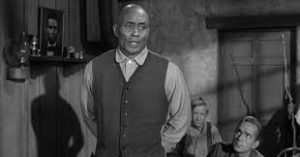 The Man Who Shot Liberty Valance was set in 1876, only a decade after the Civil War that freed the Black slaves. We know why Pompey cannot read. It was because under the laws of the slave states of the South it was illegal to teach a slave to read. However, this is not John Ford’s only point. John Ford is giving us much more than just a lesson in civics. He is also engaging in a very powerful act of social criticism in this film. To understand why he is doing this you need some background information. Before going on to the next part of my lecture, please read the short essay: Reconstruction, Voter Suppression and Segregation in America.
The Man Who Shot Liberty Valance was set in 1876, only a decade after the Civil War that freed the Black slaves. We know why Pompey cannot read. It was because under the laws of the slave states of the South it was illegal to teach a slave to read. However, this is not John Ford’s only point. John Ford is giving us much more than just a lesson in civics. He is also engaging in a very powerful act of social criticism in this film. To understand why he is doing this you need some background information. Before going on to the next part of my lecture, please read the short essay: Reconstruction, Voter Suppression and Segregation in America.
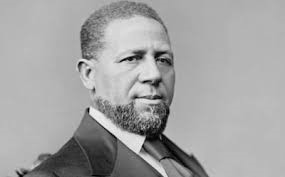 Following the U.S. Civil War, there was a period called “Reconstruction” in the South. During this period, the Union Army of the North occupied the South in order to make sure that no further insurrection would occur and that the institution of slavery was truly abolished. During this time, federal troops occupying the South ensured that the newly freed Black American citizens had the right to vote.
Following the U.S. Civil War, there was a period called “Reconstruction” in the South. During this period, the Union Army of the North occupied the South in order to make sure that no further insurrection would occur and that the institution of slavery was truly abolished. During this time, federal troops occupying the South ensured that the newly freed Black American citizens had the right to vote.
The freed slaves used their right to vote to elect Black representatives to both the United States Congress and the State legislatures. For a brief time, it looked like true democracy in the South would take hold.
Reconstruction did not fail, it was betrayed. The presidential election of 1876 was the closest in American history and was disputed in much the same way that the 2020 election is being disputed now (as I write this essay in November of 2020). Interestingly, the admission of Colorado as the 38th state in the union occurred just before the election. In The Man Who Shot Liberty Valance, Ransom Stoddard, as a pro-statehood representative, would have been a Democrat. The Democrats in the U.S. Congress (who held the majority) believed Colorado would vote for their presidential candidate so they strongly supported statehood because it would give them Colorado’s three new votes in the electoral college (U.S. presidents are elected by votes in the “Electoral College” not by the popular vote). But Colorado voters surprised everyone by voting for the Republican. Did it matter? Hayes won in the final count of the Electoral College 185 to 184. Yes, Colorado mattered very much. If Colorado had not been admitted as a state the vote would have been 184 to 182 and Samuel Tilden, the Democrat, would have been elected president! In other words, in the fictional world of the movie, Ransom Stoddard changed the course of American history!
At that time, the Republicans were the party of the North in charge of Reconstruction (and so protecting the rights of the Black minority) and the Democrats were the party of the South associated with discrimination and ending Reconstruction and voting rights for Blacks, (exactly the opposite of where both parties are today, by the way). So, if the Republicans won the election why did Reconstruction end? It ended because the final deal to which both parties agreed was to accept the Republican candidate, Rutherford B. Hayes, as President, but also to end the military occupation of the South and Reconstruction. This was the price Democrat’s demanded for not contesting the election further.
The most important point about this election is that the deal to which both Democrats and Republicans agreed, robbed Blacks in the South of the right to vote. Blacks did not regain that right for ninety years. This completely changed the course of American history.
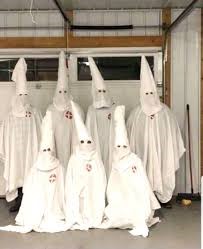 “Reconstruction” was supported by the military occupation of the South by Northern Union troops. Without the military occupation to stop them, White Southerners quickly overturned all the achievements of “reconstruction” and began to systematically deny the vote to the freed Black slaves (who were now full U.S. citizens). White Southerners did this by making the new rules for voting impossible for Blacks to meet. One rule stated that if a man’s grandfather owned land in the state he had the right to vote regardless of whether he could read or write. This allowed many White Southerners to vote (regardless of their literacy), but since no slave’s grandfather had ever owned land in any slave state, it did not give voting rights to any Blacks, no matter how many generations their families had lived in the state (some went back five generations or more). The second rule stated that unless a man’s grandfather had owned land in the state (i.e., been White) he was required to pass a “literacy test”. Since it had been illegal for Blacks to learn to read and write, very few could pass a literacy test. With these simple laws, more than 95% of Blacks were denied the right to vote. In other words, this is a perfect example of how a system of corrupt laws can completely deny people justice. It reminds us that laws that are not grounded in a true democracy usually only serve the interests of the powerful.
“Reconstruction” was supported by the military occupation of the South by Northern Union troops. Without the military occupation to stop them, White Southerners quickly overturned all the achievements of “reconstruction” and began to systematically deny the vote to the freed Black slaves (who were now full U.S. citizens). White Southerners did this by making the new rules for voting impossible for Blacks to meet. One rule stated that if a man’s grandfather owned land in the state he had the right to vote regardless of whether he could read or write. This allowed many White Southerners to vote (regardless of their literacy), but since no slave’s grandfather had ever owned land in any slave state, it did not give voting rights to any Blacks, no matter how many generations their families had lived in the state (some went back five generations or more). The second rule stated that unless a man’s grandfather had owned land in the state (i.e., been White) he was required to pass a “literacy test”. Since it had been illegal for Blacks to learn to read and write, very few could pass a literacy test. With these simple laws, more than 95% of Blacks were denied the right to vote. In other words, this is a perfect example of how a system of corrupt laws can completely deny people justice. It reminds us that laws that are not grounded in a true democracy usually only serve the interests of the powerful.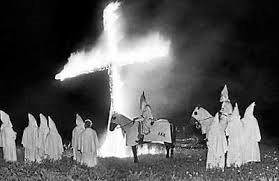
Moreover, even if a Black man learned to read and write in the South, Whites used violence and terror to prevent him from voting. The main White terrorist organization in the South was the Ku Klux Klan (KKK) a White supremacist organization that still exists today. The KKK would routinely terrorize, torture, and kill Black men who tried to vote or exercise other rights (such as appealing to the courts).
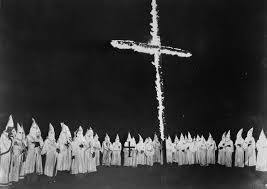 Nevertheless, public schools gradually increased in the South and literacy slowly increased for both Whites and Blacks. However, all the schools in the South were “segregated” (meaning that there were schools for Whites only, while other much less well-funded schools were for Blacks and other non-Whites). In addition to segregation in schools, there was also segregation in almost all places of business and public facilities. Almost all hotels, restaurants, and many other places of business were “White only” with Blacks being forced to go to their own Black-run places of business. This was true even if the staff in the hotel or restaurant were Black. Black cooks often worked in “White only” restaurants where they could not sit at a table and eat the food which they themselves had cooked! Trains, buses, and taxis were either White only or had only small sections reserved for Blacks. Segregation did not only exist in the South, it existed throughout the entire United States including the West. In The Man Who Shot Liberty Valance you might notice that Pompey is not allowed to eat in the dining room of Peter and Nora’s restaurant nor is he allowed to drink in the “White only” saloon. He is most certainly not allowed to vote in the election for territorial representative (even though he is guarding the election from outside with his rifle).
Nevertheless, public schools gradually increased in the South and literacy slowly increased for both Whites and Blacks. However, all the schools in the South were “segregated” (meaning that there were schools for Whites only, while other much less well-funded schools were for Blacks and other non-Whites). In addition to segregation in schools, there was also segregation in almost all places of business and public facilities. Almost all hotels, restaurants, and many other places of business were “White only” with Blacks being forced to go to their own Black-run places of business. This was true even if the staff in the hotel or restaurant were Black. Black cooks often worked in “White only” restaurants where they could not sit at a table and eat the food which they themselves had cooked! Trains, buses, and taxis were either White only or had only small sections reserved for Blacks. Segregation did not only exist in the South, it existed throughout the entire United States including the West. In The Man Who Shot Liberty Valance you might notice that Pompey is not allowed to eat in the dining room of Peter and Nora’s restaurant nor is he allowed to drink in the “White only” saloon. He is most certainly not allowed to vote in the election for territorial representative (even though he is guarding the election from outside with his rifle).
It is also important to note that Blacks were not the only people subjected to segregation (and other forms of discrimination). American Indians, Asians, Latinos, and Jews were all, to one degree or another, segregated from mainstream American society, (although a majority of Jews were considered “White”, many Christians in America refused to accept them into the broader community and they were as segregated as other “non-White” groups).
Part 3 – In 1876, when the events in this film are set, almost all American public schools (not just those in the South) were segregated by race. When John Ford shows us that Pompey is not allowed to eat in the restaurant or drink in the saloon or vote in the election, he is showing America as it was in 1876. Now let me shock you. Segregation still existed at the time this film was made in 1962!
This is why the school scene is so powerful. In Ransom’s school everyone is welcome; Pompey, the Mexican American children, the new immigrants, women as well as men. John Ford was not just showing the film audience how important basic education was in the old West, he was showing the audience how important integrated (mixed race) education was in 1962! He is offering powerful social criticism of his own time in a film that is set in history but speaks to the present. This is what he did in 1939 (the end of the Great Depression) when he made the real bad guy in Stagecoach the banker Gatewood who steals money from his own bank.
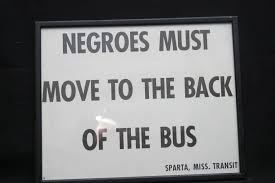
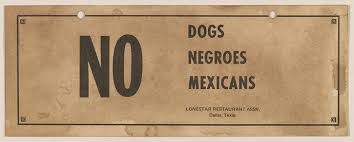
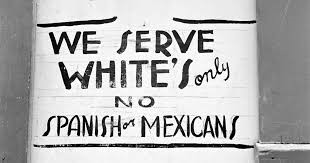
At one point, when he is quoting from the Declaration of Independence, Pompey cannot remember the part that comes after “we hold these truths to be self -evident…”. Ransom gently finishes the quote; “that all men are created equal”. Pompey says he “just forgot” that part. Isn’t it far more likely that he never knew it because his White master not only never allowed him to learn to read, but would never have allowed a slave to hear the words “all men are equal”? Slaves were not “equal” to their masters.
When John Ford made The Man Who Shot Liberty Valance in 1962, the practice of segregated schooling still existed not only in the South but in most of America. White racism was at its worst in the American South, but it existed throughout the entire United States (and still does). Let me personally put this into perspective for you. I was born the year this film was made and the schools I attended, even in the very liberal northeastern city of Boston, were still almost completely segregated by race. In my school, we had hundreds of white children, but only two Black children. They were allowed to attend my school because they lived in my town, but they lived in a very restricted part of the town where Back families were allowed to live. In the South, these children would never have been allowed to attend school with the white children under any circumstances.
By showing us a racially integrated school, John Ford was “shaming” us. He was criticizing the American society of 1962 for failing to do what Ransom Stoddard did in 1876. It wasn’t Pompey who forgot that “all men are created equal”. It was white Americans who refused to accept those words.
Part 4 – While the most powerful take away from the school scene is about the need for integration and “all men being equal”, Ford is also making the more obvious point that literacy is a necessary foundation for a society of laws, not of men. Ransom wrote “Education is the basis of Law and Order” on his school chalkboard.
But he makes still another important point when he says that an honest newspaper is “the best textbook in the world”. Here Ford is reminding us of the importance of “the fourth estate” in America. The term “fourth estate” (or fourth power) refers to the press and news media.
One of the most important guarantees of the U.S. Constitution is a free press, free from government control or censorship. “Free”, I hasten to add, does not mean “fair”. Newspapers and other mass media in the United States are exceptionally free but also often extremely partisan. For example, almost every major newspaper in America was aligned with either the Democratic Party or the Republican Party in the election of 1876. Much of what the papers wrote was not “fair’, but since both sides were “free” to write what they wanted there might not have been much fairness, but there was balance between the two sides. Ford’s newspaperman, Dutton Peabody, has very high journalistic standards for the time, however. Peabody is, like Doc Boone, one of Ford’s favorite character types, the good drunk. Despite being an alcoholic, Doc Boone turned out to be a fine doctor. Dutton Peabody is every bit the alcoholic Doc Boone was, but he is also just as capable as a newspaperman as Doc Boone was a doctor. Perhaps I may have mentioned that John Ford, one of the world’s greatest film directors, was also every bit as much an alcoholic as Doc Boone or Dutton Peabody.
When Tom reports that Liberty Valance and his gang have murdered two farmers, Mr. Peabody says he will put this in his newspaper despite Tom’s warning that Valance will “kill you sure as hell” if he does. Mr. Peabody refuses to be intimidated because, he says humbly, his job is to report “the truth”. Tom says that Mr. Peabody has written some “noble words”, but Peabody has only written the truth and expressed his own opinion in an editorial about how the citizens of the territory should vote. But Tom warns him that “votes won’t stand up to guns”. He is reminding everyone of “the law of the West”. This talk greatly disturbs Ransom who has Hallie dismiss the class and erases the words “Education is the basis of Law and Order” from his chalkboard. Is he giving up?
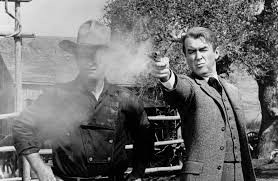 Part 5 – We then learn that Ransom is practicing with a gun in order to do what Tom said he must do to stand up to Liberty Valance. But Hallie is frightened that Ransom will get himself killed and sends Tom to try to talk some sense into him. Her concern makes Tom believe she has become romantically interested in Ransom and Tom says as much to Ransom who angrily denies the accusation.
Part 5 – We then learn that Ransom is practicing with a gun in order to do what Tom said he must do to stand up to Liberty Valance. But Hallie is frightened that Ransom will get himself killed and sends Tom to try to talk some sense into him. Her concern makes Tom believe she has become romantically interested in Ransom and Tom says as much to Ransom who angrily denies the accusation.
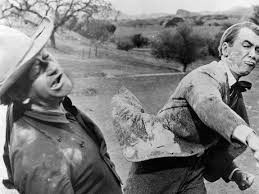 It is at this point in the film that we begin to realize that the relationships between the main characters are more complicated than we thought. Obviously, the main conflict in the film is between Ransom Stoddard and Liberty Valance over whether the rule of law or lawlessness will prevail. The only reason Valance hasn’t simply killed Ransom up until now is that Tom has been protecting him. But now it seems that there may be a rivalry emerging between Ransom and Tom over Hallie. Tom’s nasty trick with the paint cans was supposed to warn Ransom about how tricky and dangerous Liberty Valance could be, but it might also have been a warning to Ransom to stay away from Hallie. In a moment of good, well-justified rage, Ransom knocks Tom down with a punch. Tom Is obviously impressed by just how much of a punch Ransom packs (with a punch like that, perhaps if Ransom were to box with Liberty he might have a good chance of beating him).
It is at this point in the film that we begin to realize that the relationships between the main characters are more complicated than we thought. Obviously, the main conflict in the film is between Ransom Stoddard and Liberty Valance over whether the rule of law or lawlessness will prevail. The only reason Valance hasn’t simply killed Ransom up until now is that Tom has been protecting him. But now it seems that there may be a rivalry emerging between Ransom and Tom over Hallie. Tom’s nasty trick with the paint cans was supposed to warn Ransom about how tricky and dangerous Liberty Valance could be, but it might also have been a warning to Ransom to stay away from Hallie. In a moment of good, well-justified rage, Ransom knocks Tom down with a punch. Tom Is obviously impressed by just how much of a punch Ransom packs (with a punch like that, perhaps if Ransom were to box with Liberty he might have a good chance of beating him).
Part 6 – During the elections, the people (many of whom sent their children to Ransom’s school or attended classes there themselves), completely reject Liberty Valance (even though he threatens them with violence “when you are alone”). They use their votes to elect the two best men in the town to represent them; their teacher, Ransom, and their ”conscience”, the newspaper editor, Mr. Peabody. Democracy has worked. This is a huge victory for Ransom and he knows it. When democracies work, they provide the people with a means by which they can make laws to govern themselves and establish the rule of law, not of men. The beginning of law and order is the beginning of the end for Liberty Valance and men like him. But it is not the end yet.